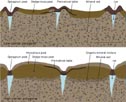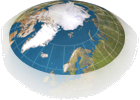 |
The Changing
Arctic Ecosystem |
| |
If you follow the system over decades
or centuries you see periods of naturally warmer or cooler climates.
Short periods of cooling may be caused by volcanic ash circulating
in the stratosphere and reducing radiation for a few years as with
eruption of Tambora in 1815, Krakatau in 1883 and Pinatubo in 1991.
Longer periods of change result from shifts in the balance of two
major circulation systems - the North Atlantic Oscillation which
results from cold air from the North meeting warm air from the South,
and the Global Conveyer Belt which brings warm water to the North
where it is cooled by Arctic waters and returns South. Changes in
these atmospheric and oceanic systems produce climatic shifts such
as the Little Ice Age of the 16th and 17th centuries. Thus the
Arctic experiences long-term fluctuations as well as the dramatic
seasonal changes. Ice and snow extends and retreats, glaciers flow
and carve U-shaped valleys in softer rocks, deposit moraines and
change the shape of the land . Rivers surge, carving new channels
and extending flood plains or the flow rate slows and sediment is
deposited further downstream and the flood plains become drier with
fewer pools. |


|
The land surface is repeatedly perturbed
by freezing and thawing (cryoturbation), the permafrost and ice
wedges slowly move up or down as climate changes, generating diverse
patterns on flat and sloping ground (see figure
6).As glaciers and snowbeds retreat, plant growth increases,
organic matter accumulates as soils mature and peat forms on wet
ground. On land and in the sea the boundaries of plants and animals
extend or retreat at both the northern and southern ends of their
geographical range. On the islands and mountain tops, species which
are at the edge of their ranges may become locally extinct - they
have nowhere to go. |
| |
Over millennia, even the surface of
the Earth responds to climate change, rising and falling as the
weight of the ice mass changes, creating new raised (or sunken)
beaches and river terraces, and causing rivers to change direction.
You notice this over millennia, but you can also measure the current
rise of 2-3 mm per decades in some areas - one of many slow but
continuous processes within the Arctic Ecosystem. |


Glacier ice and sea ice in Greenlandic fjord. Islands and valleys
emerge when the ice retreats. Photo: Jónas Allansson, 2001 |
Climate variability has shaped the
Arctic and been a way of life for millennia. Not only does it vary
over time, it also varies in different parts of the region. Animals
and plants which are best adapted to the conditions prevailing at
the time are the ones which survive and thrive. But local habitats
can be very varied and are particularly important on land where
the climate is most severe and changeable. Warm sheltered south-facing
pockets of land enable species which are less cold-tolerant to survive.
Damp or wet depressions in a dry landscape are refuges for species
during periods of low precipitation. Freeze-thaw perturbations allow
species which are good colonisers but poor competitors to survive.
Thus physical variety in the landscape and the past history of climate
variability has selected animals and plants which may be 'pre-adapted'
to resist the pressures of future changes in climate. |
|


